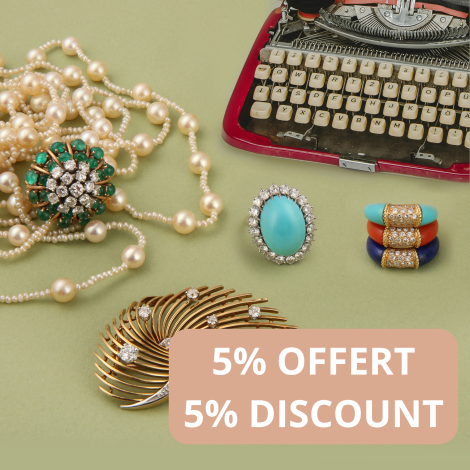Art Nouveau: Metamorphosis of a Jewel

The Art Nouveau movement emerged in England around 1860, as a direct result of the Arts & Crafts movement which, in the wake of the industrial revolution and the automation of work, advocated as a return to craftsmanship and to the creation of beautiful, utilitarian and aesthetic objects.
It was an international movement freely inspired by nature, women, flora, symbolism, the marine world and antiquity.
In Germany, it was known as Jugendstil, in England as Arts & Crafts and in Austria as the Cecession.
In France, it coincided with the Belle Époque (1890-1914) and was affectionately known as the "noodle style", as it favored arabesques over straight lines.
In architecture, it is best represented by Hector Guimard and his famous underground stations.
In the decorative arts, it was the « École de Nancy », around Émile Gallé and René Lalique, who best symbolized this revival.
For paintings, the great representatives of this movement known as "symbolism" were Gustave Moreau, Odilon Redon and Pierre Puvis de Chavannes, not forgetting Alfons Mucha and his famous posters.
Ceramists, cabinetmakers, artists, glassmakers and jewelers all joined in, advocating for a return to nature and simplicity.
Louis Majorelle, Émile Gallé, René Lalique and Gustave Klimt made their mark at the 1900 Paris World's Fair.
« Un Art Nouveau, Métamorphose du bijou (1880-1914) », the exhibition presented at the « École des arts joailliers » with the support of Van Cleef and Arpels, takes us on a journey back to this period through a selection of cutting-edge jewelry.

Gold, silver and diamond Trois Fleurs brooch by Boucheron, circa 1893-1895
It brings together sublime pieces by some of the movement's best-known and most inventive masters, including René Lalique, Georges Fouquet and Maison Vever.
There is also a subtle but highly interesting presence of Art Nouveau jewelry from other major French houses, such as Boucheron and Gaston Chopard.

Cigales comb in tortoiseshell, enamel, enameled gold and pearls by Gaston Chopard, circa 1903
The exhibition is divided into three sections: « Natures Féeriques », « Éclosions » and Abstractions.
Art Nouveau in Jewellery
The rise of a new aesthetic centered on nature, with representations of flowers, insects, animals or the female body and its attributes, for example, influenced the jewelers of the period.
It's a re-imagining of jewelry as an artistic vector that goes beyond adornment.
It was inspired by several currents: historicism, orientalism, but above all symbolism (emphasizing symbols rather than facts, born in opposition to naturalism) and romanticism (linked to romance, adventure, nature and the expression of feelings and states of mind).
Jewelry's move towards art was accompanied by a transformation of the materials used: the use of noble materials was no longer a necessity. Enamel in particular, but also glass and mosaics, took off.
Stones commonly used were opal, topaz, peridot, garnet, pearls (often fine) and diamonds.
Stones, pearls and diamonds were mixed with enamel, glass and gold...
The most famous jewelers
There are three: Maison Vever, René Lalique and Georges Fouquet.
Maison Vever
Maison Vever was founded in 1821 by Pierre-Paul Vever. In 1871, the Vever family moved to the 19 rue de la Paix, and in 1875 Ernest Vever became president of the « Chambre syndicale de bijouterie, joaillerie et orfèvrerie ». Henri Vever was one of the leading men of art nouveau, opposing classicism that reigned at the time. This led to the creation of jewelry that broke the codes of traditional jewelry and featured new, unconventional materials: horn, molten glass and translucent enamel, also known as "émail-plique-à-jour", one of Vever's hallmarks.

Apparitions brooch in gold, enamel, ivory and topaz made by Eugène Grasset (designer, illustrator and decorator) for Maison Vever, 1900
We can also mention the 3 Fs: Female, Fauna and Flora, intrinsic inspirations to art nouveau.
Interestingly, Lalique and Fouquet have also worked for Vever.
The company won numerous prizes at world's fairs: 9 in total...
Vever counted the most influential people of the time among its customers: Empress Eugénie, Tsar Alexander III and the Shah of Persia.

Le Parfum or La Rosée pendant in gold, silver, platinum, enamel, diamonds, opals and pearl by René Rozet (sculptor) for Maison Vever, 1900
A gradual decline appeared with the arrival of the art deco movement, which led to Vever's demise in 1982.
Nevertheless, in 2021, the jewelry company was relaunched by direct descendants Camille and Damien Vever.
René Lalique
René Lalique started out as a designer for other jewelers such as Fouquet, Vever and Boucheron.
His passion for jewelry and his desire to create were expressed in drawings from an early age. As a teenager, Lalique sketched jewels and approached jewelers to work with them as a designer.

Glycine Brooch-Plaque in gold, opals and diamonds by René Lalique, circa 1900
In 1885, he inaugurated his own jewelry brand. He also drew inspiration from flora and fauna, particularly peacocks, insects and the occasional fantastical animal. He used enamel, leather, mother-of-pearl and fine to precious stones for his phantasmagorical creations. His first jewels using these materials were exhibited at the 1900 World Fair, bringing him international recognition and establishing his style through the appearance and decoration of his unique stand.

Chrysanthème Brooch-Pendant in gold, enamel, glass, diamonds and pearls by René Lalique, 1900
He was also a great master glassmaker, registering patents for press-molded glass and double-bottomed glass. He had a factory built to produce his jewels in large quantities.
He is one of the most emblematic jewelers of Art Nouveau, and his iconic pieces can fetch tens of thousands of euros, even millions.
Georges Fouquet
The saga of the House of Fouquet began in 1860, when Alphonse Fouquet set up his store in Paris, offering typical « belle époque » jewelry. He was a great success, exporting abroad and even exhibiting some pieces at the 1878 World Fair.
Two years later, his son Georges, aged 18, joined the company and began his apprenticeship. Strongly influenced by the Art Nouveau movement, his first collection, presented in 1898, featured orchids and butterflies with curved lines, set with colored enamels, opals, horn, pearls and, occasionally, diamonds.
But it wasn't until the 1900 World Fair that his name figured among the masters of Art Nouveau, a success reinforced by his collaboration with the artist Alphonse Mucha.

Serpent de Mer Ailé corsage ornament in gold, enamel, emerald and pearls by Georges Fouquet, 1902
It was Sarah Bernhardt who introduced Mucha to Fouquet (or vice versa), as she wanted him to make a bracelet based on a Mucha design.
In 1901, he opened a sublime boutique at 6 rue royale, decorated by Alphonse Mucha.

Gold, enamel, opal mosaic and diamonds Nymphe des Mers pendant by Georges Fouquet, circa 1900-1905
After 1910-1920, Art Nouveau began to fade, but George Fouquet was able to adapt to the new demand for hair jewelry and headbands adorned with diamonds and feathers, synonymous with the Art Deco movement.
He was again present at the 1925 International Decorative Arts Exhibition. His son Jean took over, but the company was forced to close in 1936, following the stock market crash of 1929.
Georges died in 1957.
If, like us, you're passionate about Art Nouveau and jewelry from this period, we urge you to visit the exhibition, and why not take the opportunity to tour Place Vendôme and its great jewelers...
Our thanks to the Ecole des Arts Joailliers for this magnificent exhibition.
If you are interested in antique arts nouveaux jewels, do not hesitate to discover what Les Pierres de Julie has to offer in store...
We are also available for any free expertise of your arts nouveaux jewelry, for that you can send an email with your photos tocontact@lespierresdejulie.com.
Whether you're interested in buying a piece of jewellery or a stone, a free jewelry appraisal or jewelry resale, Pierres de Julie welcomes you to its Parisian boutique in the Village Suisse, a stone's throw from the Ecole Militaire and the Esplanade des Invalides.
Nouveautés
- 18.000 €
- 18.000 €
- Unit price
- / per
- 1.800 €
- 1.800 €
- Unit price
- / per
- 1.950 €
- 1.950 €
- Unit price
- / per
- 5.950 €
- 5.950 €
- Unit price
- / per











